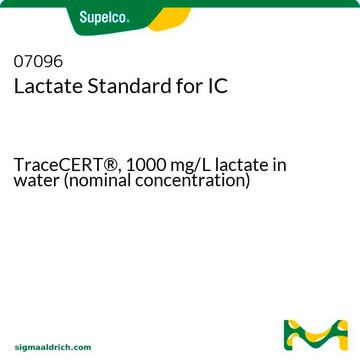1356734
USP
Lactic acid
United States Pharmacopeia (USP) Reference Standard
Sinônimo(s):
DL-Lactic acid, 2-Hydroxypropionic acid
About This Item
Produtos recomendados
grau
pharmaceutical primary standard
família API
lactic acid
Ensaio
89.1% (lactic acid basis)
fabricante/nome comercial
USP
técnica(s)
HPLC: suitable
índice de refração
n20/D 1.425 (lit.)
pb
122 °C/15 mmHg (lit.)
densidade
1.209 g/mL at 25 °C (lit.)
aplicação(ões)
pharmaceutical (small molecule)
formato
neat
temperatura de armazenamento
2-8°C
cadeia de caracteres SMILES
CC(O)C(O)=O
InChI
1S/C3H6O3/c1-2(4)3(5)6/h2,4H,1H3,(H,5,6)
chave InChI
JVTAAEKCZFNVCJ-UHFFFAOYSA-N
Procurando produtos similares? Visita Guia de comparação de produtos
Categorias relacionadas
Descrição geral
Aplicação
Also, for use with USP monographs such as:
- Fumaric Acid
- Maleic Acid
Nota de análise
Outras notas
produto relacionado
Palavra indicadora
Danger
Frases de perigo
Declarações de precaução
Classificações de perigo
Eye Dam. 1 - Skin Corr. 1C
Perigos de suplementos
Código de classe de armazenamento
8A - Combustible corrosive hazardous materials
Classe de risco de água (WGK)
WGK 1
Ponto de fulgor (°F)
235.4 °F - closed cup
Ponto de fulgor (°C)
113 °C - closed cup
Certificados de análise (COA)
Busque Certificados de análise (COA) digitando o Número do Lote do produto. Os números de lote e remessa podem ser encontrados no rótulo de um produto após a palavra “Lot” ou “Batch”.
Já possui este produto?
Encontre a documentação dos produtos que você adquiriu recentemente na biblioteca de documentos.
Os clientes também visualizaram
Protocolos
Separation of DL-Lactic acid, ~90% (T)
Science Slam panel: Leading gene therapy developers discuss commercialization challenges and the importance of robust process development plans.
Nossa equipe de cientistas tem experiência em todas as áreas de pesquisa, incluindo Life Sciences, ciência de materiais, síntese química, cromatografia, química analítica e muitas outras.
Entre em contato com a assistência técnica




